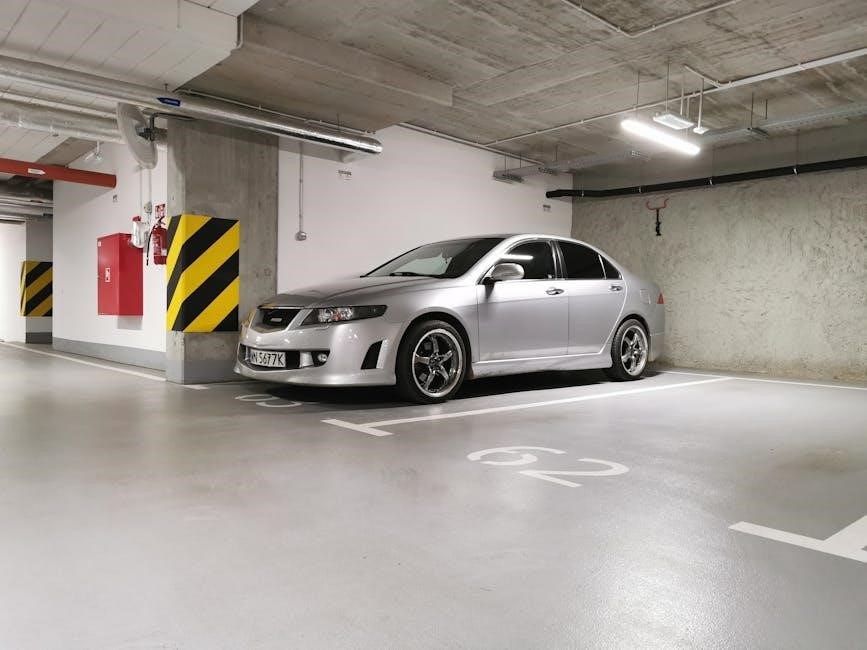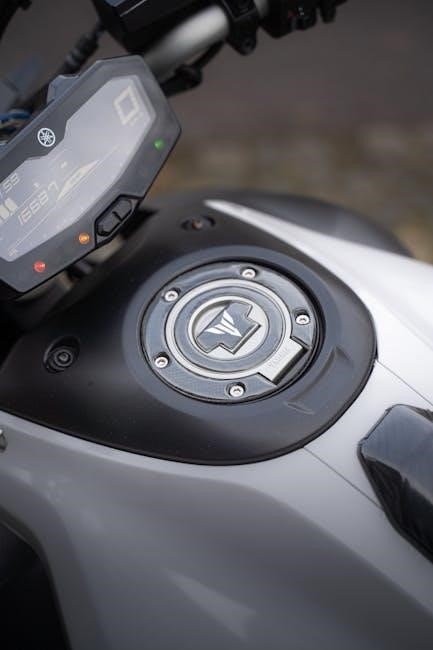Welcome to the 2014 Honda Accord owner’s manual․ This guide provides essential information for safe and efficient operation of your vehicle, including features, maintenance, and troubleshooting․
1․1 Overview of the 2014 Honda Accord
The 2014 Honda Accord is a reliable and feature-packed vehicle offered in sedan and coupe models․ Known for its fuel efficiency and performance, it features a front-engine, front-wheel-drive layout․ The Accord boasts a 2․4L inline-4 engine, delivering smooth power and excellent mileage․ With advanced safety features like airbags and electronic stability control, it ensures a secure driving experience․ The 2014 model also includes modern amenities such as Eco Assist, touchscreen systems, and Bluetooth connectivity, making it a versatile choice for drivers seeking comfort and functionality․
1․2 Purpose of the Owner’s Manual
The owner’s manual serves as a comprehensive guide to help drivers understand and maintain their 2014 Honda Accord․ It provides detailed instructions on vehicle operation, safety features, and maintenance routines․ The manual ensures safe driving practices, helps extend the vehicle’s lifespan, and enhances overall ownership experience by covering essential information on features, troubleshooting, and proper care․ It is designed to remain with the vehicle, even when sold, ensuring continuity of knowledge for future owners․
1․3 Structure and Organization of the Manual
The 2014 Honda Accord manual is organized into sections for easy navigation․ It begins with an introduction, followed by safety precautions and instrument panel details․ Subsequent sections cover seating, driving procedures, maintenance, troubleshooting, emissions, technical specifications, accessories, and additional resources․ Each chapter is designed to address specific aspects of vehicle ownership, ensuring that drivers can quickly find relevant information․ The manual’s logical structure enhances readability, making it a user-friendly resource for all owners․

Safety Precautions and Important Information
Read this manual carefully to understand safety features, warning labels, and proper vehicle operation․ Always follow safety guidelines to ensure driver and passenger well-being while driving․
2․1 Essential Safety Tips for Drivers
Always wear your seatbelt and ensure all passengers do the same․ Adjust mirrors and seats for optimal visibility and comfort․ Keep hands on the wheel and eyes on the road․ Avoid distractions like texting or using phones while driving․ Maintain a safe distance from other vehicles․ Be aware of weather conditions and adjust speed accordingly․ Familiarize yourself with vehicle features to ensure safe operation․ Regularly check tire pressure and brakes for optimal safety․ Never drive under the influence of alcohol or drugs․ Stay alert and follow all traffic laws․
2․2 Understanding Warning Labels and Symbols
Warning labels and symbols in your 2014 Honda Accord are crucial for safety․ They alert you to potential hazards and essential maintenance needs․ Common symbols include airbag warnings, seatbelt reminders, and engine alerts․ These labels are located on the dashboard, doors, and under the hood․ Always investigate unfamiliar symbols or messages․ Ignoring warnings can lead to safety risks or vehicle damage․ Refer to the manual for detailed explanations of each symbol to ensure proper understanding and response․ Stay informed to maintain your safety and the vehicle’s condition․

Instrument Panel and Controls
The instrument panel features a speedometer, odometer, fuel gauge, and warning lights․ Controls for climate, audio, and driver assistance systems are centrally located for easy access and operation․
3․1 Dashboard Layout and Components
The 2014 Honda Accord’s dashboard is designed for functionality and clarity․ It includes a central touchscreen for infotainment, climate controls, and a digital display for essential vehicle information․ The instrument cluster features a speedometer, tachometer, fuel gauge, and warning lights․ Buttons for cruise control and audio adjustments are mounted on the steering wheel, while vents and switches for heating and cooling are intuitively placed for easy access․ This layout ensures a distraction-free and comfortable driving experience․
3․2 Explanation of Warning Lights and Indicators
The 2014 Honda Accord features a range of warning lights and indicators on the instrument panel․ These include the oil indicator, battery alert, and check engine light․ Each light signifies a specific issue, such as low oil levels or system malfunctions․ The manual details what each light represents and the appropriate actions to take when they illuminate․ Understanding these indicators ensures timely responses to maintain vehicle health and safety․

Seating and Safety Features
This section covers proper seat adjustments, safety belt usage, and airbag systems․ Ensure seats are adjusted for optimal comfort and visibility, and always wear seat belts for safety․
4․1 Adjusting Seats for Comfort and Safety
Adjusting your seat properly is crucial for comfort and safety while driving․ Use the manual controls to position the seat height, lumbar support, and tilt for optimal posture․ Ensure your feet can reach the pedals without stretching and maintain a clear view of the road․ For vehicles with power seats, use the electronic controls to fine-tune your position․ Always check mirrors and adjust your seat to minimize blind spots, ensuring a safe and comfortable driving experience․
4․2 Overview of Airbag Systems and Safety Belts
The 2014 Honda Accord is equipped with a comprehensive airbag system, including dual front airbags, side airbags, and side curtain airbags, to enhance occupant protection in collisions․ The airbags deploy in conjunction with the seatbelt system to reduce injury risk․ Always wear safety belts correctly, ensuring proper fit and positioning; Passengers should also fasten their seatbelts to maximize safety․ Follow the manual’s guidelines for maintaining and inspecting the airbag and safety belt systems to ensure optimal functionality․

Starting and Driving the Vehicle
Proper procedures for starting the engine, shifting gears, and operating the vehicle safely are detailed in this section․ Key guidelines for smooth acceleration, braking, and handling are included․
5․1 Procedures for Starting and Stopping the Engine
Insert the key into the ignition and turn it to the “START” position․ Press the engine start button while ensuring the parking brake is engaged․ Shift into “P” or “N” gear for automatic or manual transmissions, respectively․ To stop the engine, shift to “P” (automatic) or first gear (manual), engage the parking brake, and turn the ignition to “OFF․” Avoid leaving the ignition in “ACCESSORY” mode to prevent battery drain․ Always follow proper shutdown procedures for safety and battery preservation․
5․2 Basic Driving Tips and Guidelines
Always adjust your seat and mirrors for optimal visibility and comfort․ Ensure all occupants wear seatbelts before starting the vehicle․ Avoid distractions while driving, such as using electronic devices․ Maintain a safe following distance and obey traffic laws․ Use turn signals consistently when changing lanes or turning․ Drive smoothly, accelerating and braking gradually to enhance stability․ Regularly check your surroundings, especially when reversing or changing lanes․ Familiarize yourself with local traffic rules and weather conditions for safe driving practices․ Keep essential items like a spare tire and emergency kit in the vehicle․

Maintenance and Servicing
Regular maintenance is crucial for optimal performance and longevity․ Follow the recommended schedule for oil changes, fluid checks, and tire rotations․ Address issues promptly to prevent damage․
6;1 Recommended Maintenance Schedule
The 2014 Honda Accord manual outlines a recommended maintenance schedule to ensure optimal performance․ Regular servicing is required at specific intervals, typically every 5,000 to 7,500 miles․ This includes oil changes, tire rotations, and fluid checks․ Inspections of belts, hoses, and brakes are also recommended to prevent wear and tear․ Following this schedule helps maintain the vehicle’s efficiency, prevents costly repairs, and ensures a longer lifespan for your Honda Accord․
6․2 DIY Maintenance Tips and Procedures
Performing DIY maintenance on your 2014 Honda Accord can save time and money․ Start with regular oil changes every 5,000 to 7,500 miles․ Check and maintain proper tire pressure for improved fuel efficiency․ Replace the air filter every 15,000 miles to ensure optimal engine performance․ Inspect and top off fluids such as coolant, transmission, and windshield washer fluid․ Additionally, check the condition of belts and hoses for signs of wear․ These simple tasks can help keep your Accord running smoothly and prolong its lifespan․
6․3 Importance of Regular Servicing
Regular servicing is crucial for maintaining your 2014 Honda Accord’s performance and longevity․ It ensures safety, efficiency, and reliability․ Routine checks help identify potential issues early, preventing costly repairs․ Servicing also maintains optimal fuel efficiency and reduces emissions․ By following the recommended schedule, you protect your investment and ensure your vehicle remains in peak condition for years to come․ Regular maintenance is essential for preserving the overall health and functionality of your Accord․

Troubleshooting Common Issues
This section guides you in identifying and resolving common problems with your 2014 Honda Accord, ensuring optimal performance and minimizing repair needs through early detection․
7․1 Identifying and Solving Basic Problems
This section helps you diagnose and address common issues with your 2014 Honda Accord․ Learn to recognize warning signs, such as dashboard indicators or unusual noises․ Check for loose connections, low fluid levels, or worn components․ Refer to the manual for step-by-step solutions for issues like the check engine light or transmission problems․ For complex issues, consult a professional mechanic to ensure proper repairs and maintain your vehicle’s performance and safety․
7․2 When to Contact a Professional Mechanic
If you encounter complex issues beyond basic troubleshooting, such as persistent warning lights, unusual noises, or performance problems, consult a professional mechanic; DIY repairs for advanced systems like transmission or engine malfunctions can lead to further damage․ Always seek expert assistance for safety-critical systems or when unsure about procedures․ A certified Honda technician can provide accurate diagnosis and reliable repairs, ensuring your vehicle operates safely and efficiently․ Regular professional checks are key to long-term performance and reliability․

Emissions and Environmental Information
This section details the emissions control systems in your 2014 Honda Accord, designed to minimize environmental impact while meeting regulatory standards․ It explains how the systems function and their importance in maintaining eco-friendly performance․
8․1 Emissions Control Systems Overview
The 2014 Honda Accord features advanced emissions control systems to reduce environmental impact․ These include a catalytic converter, fuel evaporative emission controls, and exhaust gas recirculation․ The systems work together to minimize pollutants and ensure compliance with emissions standards․ Regular maintenance is crucial for optimal performance․ Proper functioning of these systems is essential for both environmental protection and vehicle efficiency․ Understanding and maintaining these components helps in reducing the car’s carbon footprint and ensuring it runs efficiently for years․

Technical Specifications
The 2014 Honda Accord features a 2․4L inline-4 engine, producing 185 horsepower and 181 lb-ft of torque․ It uses regular fuel and has a front-wheel-drive system․
9․1 Engine and Transmission Details
The 2014 Honda Accord is equipped with a 2․4-liter inline-4 cylinder engine, producing 185 horsepower and 181 lb-ft of torque․ It features a dual overhead camshaft (DOHC) design with 16 valves for efficient combustion․ The engine is paired with a 6-speed manual transmission, offering smooth gear shifts and precise control․ Fuel efficiency is optimized with Honda’s i-VTEC technology, balancing power and economy․ The transmission system ensures responsive acceleration and seamless driving experience, making it ideal for both city and highway driving conditions․
9․2 Vehicle Dimensions and Capacities
The 2014 Honda Accord Sedan measures 191․4 inches in length, 72․8 inches in width, and 57․7 inches in height, with a 109․3-inch wheelbase․ The cargo area offers 15․8 cubic feet of space, expandable with rear seat folding․ Passenger volume is 103․2 cubic feet, providing ample legroom and comfort․ The fuel tank capacity is 17․2 gallons, supporting extended drives․ These dimensions ensure a spacious interior while maintaining a compact, maneuverable design suitable for various driving needs and preferences․

Accessories and Customization
Explore compatible accessories like alloy wheels, spoilers, and interior upgrades to personalize your 2014 Honda Accord․ Enhance functionality and style with genuine Honda parts or aftermarket options․
10․1 Compatible Accessories for the 2014 Honda Accord
The 2014 Honda Accord supports various accessories to enhance its functionality and appeal․ These include alloy wheels, rear spoilers, interior trim kits, and roof racks․ Genuine Honda parts ensure perfect compatibility and durability․ Additionally, wheel locks, floor mats, and trunk organizers are popular choices for protection and convenience․ Aftermarket options offer infotainment upgrades, performance enhancements, and styling modifications․ Always choose products designed specifically for your Accord’s model year to maintain warranty and performance standards․
10․2 Tips for Personalizing Your Vehicle
Personalizing your 2014 Honda Accord allows you to tailor it to your preferences and needs․ Consider adding custom interior trim or LED lighting for a unique look․ Upgrade your audio system with compatible speakers or amplifiers․ Exterior modifications like body kits or decals can enhance its style․ For functionality, add cargo organizers or seat covers․ Always ensure modifications are compatible with your vehicle’s specifications and comply with safety standards․ Consult the manual or a professional for complex installations to avoid voiding warranties․
This concludes the 2014 Honda Accord manual․ By following these guidelines, you ensure optimal performance, safety, and longevity of your vehicle․ Enjoy your driving experience!
11․1 Final Tips for Optimal Vehicle Performance
Regular maintenance is key to extending your 2014 Honda Accord’s lifespan․ Adhere to the recommended schedule, monitor fluid levels, and ensure proper tire pressure․ Avoid extreme temperatures and aggressive driving․ Keep the interior clean to preserve materials․ Reference the manual for troubleshooting common issues․ By following these guidelines, you’ll enjoy a smooth, safe, and efficient driving experience․ Happy driving!
Additional Resources
For further assistance, visit the official Honda website or consult online forums․ Download the PDF manual from trusted sources like ManualsLib or Honda’s official portal․
12․1 Where to Find More Information
For additional details, visit the official Honda website or authorized dealerships․ Online forums, such as those dedicated to Honda Accord owners, offer valuable insights and tips․ Download the 2014 Honda Accord manual in PDF format from trusted sources like ManualsLib or Honda’s official portal․ These resources provide comprehensive guidance on maintenance, troubleshooting, and customization․ Always verify the authenticity of the source to ensure accurate and reliable information․ For personalized assistance, contact Honda support or join enthusiast communities․
12․2 Online Communities and Forums for Honda Accord Owners
Join online forums like Reddit’s r/Honda or specialized Honda Accord groups to connect with other owners․ These communities offer troubleshooting tips, DIY guides, and discussions on customization․ Share experiences, ask questions, and gain insights from seasoned owners․ Websites like ManualsLib and Honda’s official forums also provide valuable resources․ Engage with enthusiasts to enhance your ownership experience and stay updated on the latest modifications and maintenance advice․ Always verify information for accuracy before applying it to your vehicle․
